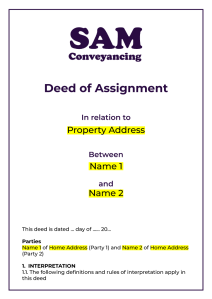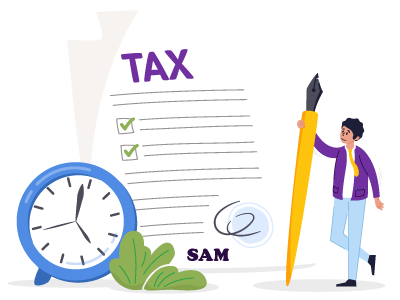How to Avoid Paying Tax on Rental Income in 2025
The tax landscape for property investors regularly evolves, and the 2025/2026 tax year brings important updates that could impact your income (20% - 45%) and capital gains (18% - 24%). This guide details legitimate strategies to reduce tax on rental income and Capital Gains Tax (CGT) on property disposals.
We'll explore methods such as transferring beneficial interest, incorporating a limited company, and leveraging allowable expenses. We'll also highlight how these strategies can interact with other taxes like Stamp Duty Land Tax (SDLT) and Inheritance Tax (IHT), ensuring you're aware of all implications.
While we provide legal services for property transfers, please note that we do not offer tax advice; always consult a qualified tax advisor or accountant for personalised guidance specific to your circumstances.
The current tax rates for rental income and capital gains (2025/26)
For the 2025/2026 tax year, both Income Tax on rental profits and Capital Gains Tax (CGT) on property disposals have specific rates and allowances you need to be aware of.
Income tax rates for rental income (2025/2026)
The amount of Income Tax you pay depends on your total income and your tax band. Here are the core Income Tax rates and allowances for the 2025/2026 tax year (note: Scottish rates may differ):
- Personal Allowance: £12,570 (this reduces by £1 for every £2 of income over £100,000, reaching £0 at £125,140).
- Basic Rate: 20% on income from £12,571 to £50,270.
- Higher Rate: 40% on income from £50,271 to £125,140.
- Additional Rate: 45% on income over £125,140.
You are liable to pay tax on rental income on the day it is received. For example, if rent is due on 31st March but received into your bank on 6th April, it falls into the next tax year for payment, even if it was due in the previous tax year.
Capital Gains Tax (CGT) on property sales and the Annual Exempt Amount (AEA)
When you sell a buy-to-let property or any residential property that is not your main home, you may be liable for Capital Gains Tax (CGT) on the profit you make.
- 18% for gains falling within the basic rate income tax band.
- 24% for higher and additional rate taxpayers.
For the 2025/2026 tax year, the AEA for individuals is £3,000 (£1,500 for trusts). This is the amount of gain you can make before CGT becomes payable. CGT on UK residential property disposals must be reported and paid to HMRC within 60 days of completion of the sale.
Sharing beneficial interest for tax purposes
If you share the beneficial interest in a property with someone else, then you only declare your share of the rental income in your tax return. Property income is shared in proportion to your beneficial interest in the property, and this should be formally declared within a Deed of Trust or Deed of Assignment.
How do you pay tax on rental income?
If you're a landlord, a common question is, "Do landlords pay tax on rent?" The answer is yes. You need to declare your rental income in your annual Self Assessment tax return, which covers the tax year from 6th April to 5th April.
- Your online tax return must be filed no later than 31st January following the previous year's 5th April (giving you 9 months to file your accounts).
- You typically make 'payments on account' towards your tax bill on 31st January and 31st July. Any balance of tax due must be paid in full by the 31st January after you've filed your tax return for the year.
- Fixed, competitive legal fees with no hidden costs.
- Expert conveyancing solicitors with proven local knowledge.
- No Sale, No Fee protection for your transaction. Terms apply.
- On 99% of mortgage lender panels.
- Fast completions.
- We can solve any property challenge.
Strategies to reduce income tax on your rental property
For landlords seeking effective tax tips for landlords and legitimate ways to avoid paying tax on rental income, several approaches can reduce your Income Tax liability on rental profits. These methods range from structuring property ownership to leveraging allowable expenses and specific tax schemes.
Transferring your buy-to-let into a Limited Company
Since the changes introduced in 2022 (often referred to as 'Section 24' changes), individual landlords are no longer allowed to offset the full amount of mortgage interest repayments from their rental income.
Instead, they receive a 20% basic rate tax credit on mortgage interest payments. This has made holding buy-to-let properties in a limited company increasingly attractive for many landlords, as companies can still fully deduct mortgage interest and other property costs from their rental income before Corporation Tax is applied.
Tax advantages of a Limited Company
- Full Mortgage Interest Deduction: Companies can fully deduct mortgage interest from rental income before Corporation Tax, unlike individual landlords.
- Corporation Tax Rates: Companies benefit from lower Corporation Tax rates compared to higher individual income tax rates; the small profits rate is 19% (for profits up to £50,000), the main rate is 25% (for profits over £250,000), and the marginal relief applies for profits between £50,000 and £250,000, resulting in a marginal rate of 26.5% on profits within this band.
-
Dividend Tax (2025/2026): Profits withdrawn as dividends are taxed at lower rates than income tax after a small dividend allowance:
- Dividend Allowance: £500.
- Basic Rate: 8.75%.
- Higher Rate: 33.75%.
- Additional Rate: 39.35%.
- Limited Liability: Provides legal protection for personal assets from business liabilities.
Disadvantages
- Stamp Duty Land Tax (SDLT): SDLT is payable at full market value, plus the additional 5% property surcharge.
- Capital Gains Tax (CGT): CGT is triggered on the disposal of the asset to the company, based on the market value at the time of transfer. You may be eligible for incorporation tax relief, allowing you to defer CGT until shares in the company are disposed of, but this is complex and requires specialist advice.
- Higher Compliance Costs: Companies incur higher accountancy fees and require more complex company filings with Companies House.
If you currently own a property in a partnership and it is run as a business (not just an investment), then you may be able to transfer the property into a limited company and avoid paying Stamp Duty Land Tax under specific conditions. This is a complex area and requires specialist advice.
Offsetting allowable expenses to reduce rental Income Tax
Even though you can't deduct the full amount of mortgage repayments from rental income as an individual landlord, you are allowed to deduct other expenses that are "wholly and exclusively" incurred to rent out the property.
Common allowable expenses
- Mortgage Interest (Individual Landlords): Individual landlords cannot deduct the full mortgage interest from rental income. Instead, they receive a 20% basic rate tax credit on their mortgage interest payments.
- Repairs to the property: Costs incurred for repairs and maintenance of rental properties are usually deductible. This includes expenses for plumbing, electrical issues, painting, and general upkeep. Note: Improvements that add value are generally not deductible but may be considered for CGT purposes later.
- Utility Charges: Costs associated with utilities such as gas, electricity, and water, as well as service charges like communal cleaning and maintenance, can be deducted if the landlord pays them.
- Council Tax and Ground Rent: These can also be offset against rental income (during void periods or if paid by landlord).
- Fees: Fees paid to letting agents for finding tenants, managing the property, and collecting rent on the landlord's behalf are all allowable expenses. Expenses related to legal advice, accountancy fees, and other professional services directly related to the property are also allowable.
- Insurance: Landlord insurance premiums are deductible.
A full list of allowable expenses to reduce the tax on rental income is set out on the HMRC website: HMRC - Allowable expenses.
Carrying over rental property losses
If, in any tax year, the allowable outgoings from your rental business are more than the rental income (for example, due to having an empty flat or needing to do large repair works), then these losses can be used to reduce any profit made in future tax years. This is a valuable strategy for managing your tax liability over time.
How to calculate and utilise rental property loss
- Identifying Rental Loss: Determine the net profit or loss from rental activities for the tax year by accurately subtracting all allowable expenses from your total rental income.
- Assessing Allowable Expenses: Ensure all eligible expenses are accurately accounted for, including the 20% tax credit for mortgage interest payments, repairs, maintenance, letting agent fees, insurance, and other relevant costs.
- Offset Against Future Rental Profits: In England & Wales, rental property losses can typically be carried forward indefinitely and used to offset future rental profits from the same property business.
- Restrictions on Loss Relief: There may be restrictions on the amount of losses that can be offset against other income, depending on your tax status and circumstances.
- Tax Planning Considerations: It's advisable to consult with a tax advisor or accountant to fully optimise the use of rental property losses, as they can guide you through specific tax rules and regulations.
Rent a Room Scheme
The Rent a Room Scheme allows individuals to earn up to a tax-free threshold of £7,500 per year from letting out furnished accommodation in their main residence.
This scheme is particularly beneficial for those who rent out a spare room or part of their home, making it a straightforward way to reduce rental income tax on that income stream.
Landlords can use this scheme by renting out a spare room to lodgers or offering a Monday to Friday short-term let to tenants. If the rental income stays within the £7,500 threshold, you won't have to declare it on your tax return.
If your gross rental income from the scheme is more than the threshold, you can still use the scheme but will need to declare the income and choose between paying tax on the profit (rental income minus allowable expenses) or on the gross income minus the £7,500 allowance.
Our solicitors can draft your Deed of Assignment within 1 to 2 working days.
- Assign any amount of beneficial interest from 1% to 100% between the legal and non-legal owners.
- Change the beneficial interest at a future date for Capital Gains Tax purposes.
- For tenants in common.
- Does not assign debts or outgoings.

£275 INC VAT
Latest update: Abolition of the Furnished Holiday Lettings (FHL) regime
This is a critical update for landlords with Furnished Holiday Lettings (FHLs). The special FHL tax regime was abolished from 6 April 2025 (1 April 2025 for Corporation Tax).
This means that properties previously qualifying as FHLs will now be treated like any other residential letting for tax purposes, impacting their tax treatment and potentially affecting how you avoid paying tax on rental income.
Key facts of FHL abolition
- Mortgage Interest Relief: For individual landlords, mortgage interest relief will now be restricted to a 20% basic rate tax credit, similar to other residential landlords. The previous benefit of fully deducting mortgage interest will no longer apply.
- Capital Allowances: No new capital allowances can be claimed on furniture or fixtures. Only "Replacement of Domestic Items Relief" will apply, similar to other residential lets. Any existing capital allowance pools can still be written down, but no new claims for capital allowances on new items will be permitted.
- Capital Gains Tax (CGT) Reliefs: FHLs will no longer qualify for beneficial CGT reliefs such as Business Asset Disposal Relief (formerly Entrepreneurs' Relief), Rollover Relief, or Gift Holdover Relief (unless the property is part of a genuine wider trading business, which is rare for standard FHLs). Normal residential property CGT rules will now apply (18%/24% rates, £3,000 Annual Exempt Amount).
- Pension Contributions: FHL profits will no longer count as "relevant earnings" for pension contribution purposes. This could impact your ability to make tax-efficient pension contributions based on income from these properties.
Landlords with former FHL properties should seek specialist tax advice to understand the full implications for their specific circumstances and to adjust their tax planning strategies accordingly.
What Rate of Income Tax Do You Pay on Rental Income?
The income tax bands on work and rental income are as follows:
| Tax Band | Taxable Income (Employment and Property) | Tax Rate |
|---|---|---|
| Tax Band Tax free allowance | Taxable Income (Employment and Property) £12,570 | Tax Rate 0% |
| Tax Band Higher rate | Taxable Income (Employment and Property) £50,271 to £150,000 | Tax Rate 40% |
| Tax Band Additional rate | Taxable Income (Employment and Property) over £150,000 | Tax Rate 45% |
NOTE: Work and rental income are not separate. You combine all your earnings (work and rental) and then you look into your bracket.
Source: HMRC - Income Tax Rates
- Get up-to-date property tax advice on SDLT, CGT, IHT, personal vs partnership vs company structure.
- Free 15-minute initial consultation with our panel tax advisor.
- Ask your tax questions and get guidance on what you can do next.
- If further accountancy work is required, you'll be quoted for this as a separate piece of work with no obligation to purchase.

Andrew started his career in 2000 working within conveyancing solicitor firms and grew hands-on knowledge of a wide variety of conveyancing challenges and solutions. After helping in excess of 50,000 clients in his career, he uses all this experience within his article writing for SAM, mainstream media and his self published book How to Buy a House Without Killing Anyone.
Caragh is an excellent writer and copy editor of books, news articles and editorials. She has written extensively for SAM for a variety of conveyancing, survey, property law and mortgage-related articles.










